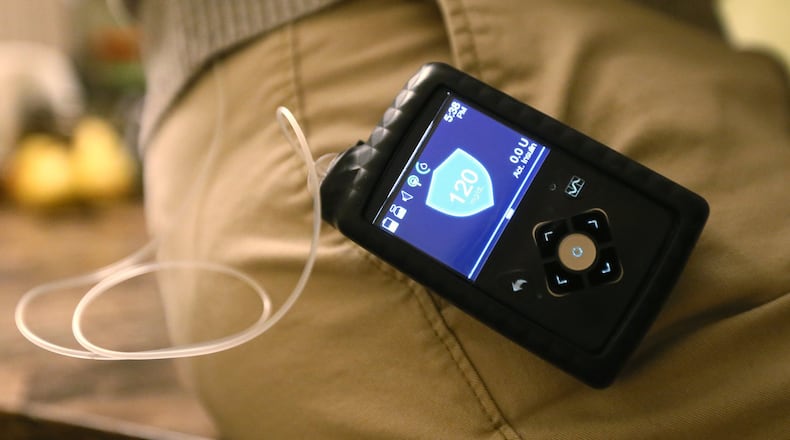The device is able to automatically adjust the rate of insulin pumped into the body by responding to blood sugar levels measured by a separate sensor.
While insulin pumps are not new, the Medtronic MiniMed 670G is able to act on its own — to an extent — relieving some of the decision-making burden for diabetics.
“I think the pump is an amazing advancement in the technology. It’s helped me out so much and it makes me feel like I’ve never been sick,” McKinney, 17, of Festus, said.
Her health has improved as a result of the new technology, according to her pediatric endocrinologist, Dr. Susan Myers of Cardinal Glennon.
She now spends 72 percent of the time in a healthy blood sugar range. That’s an improvement from 50 percent of the time when she was using a pump without the advanced technology, Myers said.
The overall health of a diabetic patient is greatly improved when blood sugar levels are tightly controlled; when they’re not it can lead to long-term complications and stress on other organs.
Many patients were so eager for this type of technology that they began to hack their own insulin pumps to automate them in this way.
Some credit these do-it-yourself patients for helping push Medtronic and the FDA to speed up the process of getting the current device to market.
They were part of the #WeAreNotWaiting movement on social media who shared instructions on how to alter insulin pumps, known as OpenAPS.
However, some say the current technology is an incremental improvement.
“It is a step in the right direction, but the first version is very conservative,” said Dana Lewis, founder of the OpenAPS system. “While this technology is good for a lot of people and better than what they’re doing now, it has the potential to do a lot more.”
Insulin is a hormone made by the body’s pancreas and is used to regulate blood sugar.
Most Americans with diabetes have Type 2, which can sometimes be eliminated with a healthier diet and exercise. About 5 percent of those diagnosed with diabetes have Type 1, according to the Centers for Disease Control and Prevention. There is no cure for Type 1.
In patients with Type 1 diabetes, the pancreas no longer produces insulin, so it falls upon the individual to deliver insulin into the body either through a single-use syringe or through an insulin pump, a device that looks similar to a pager.
The advantage of the pump is it continuously dispenses insulin over about three days, requiring only one injection and freedom from numerous daily injections of insulin via a single-use syringe or pen.
This latest Medtronic device, known as hybrid closed-loop system, is seen as an advancement in technology for the day-to-day management of the autoimmune disease, particularly during the night. It’s the first system of its kind to be approved by the FDA.
“When you don’t eat meals, especially at night, it is an ideal system,” said Dr. Satish Garg, an endocrinologist at the University of Colorado School of Medicine. Garg was a co-author on the study funded by Medtronic that examined the efficacy of the new device.
“It totally nearly prevents hypoglycemia” or what is known as low blood sugar, Garg said.
McKinney said she has noticed she’s more stable during the night.
“Nighttime is better for me overall. My nighttime lows are much more controlled,” she said.
The device automatically adjusts the drip of insulin that is received continuously throughout the day (known as the basal rate), but patients still need to administer insulin after meals. That’s why some critics say it’s just a step in the right direction. The goal is to one day have a device that would be completely automated where it would need no input by the user.
Still, McKinney said the device gives her a sense of comfort because she knows her system is working to prevent a low. It’s a serious concern for her given the fact that she drives to and from school and work.
“It’s scary to think about how I could suddenly be out of it,” McKinney said. Low blood sugar can cause diabetics to pass out. She said she trusts the technology to alert her.
It’s been a long road for McKinney and her family.
In the months leading up to her diagnosis on Aug. 9, 2016, she had an insatiable thirst. She also felt lethargic but thought it was part of being a teenager.
It turned more serious when she lost about 20 pounds in about six weeks.
After tests, she was immediately directed to Cardinal Glennon Children’s Hospital. Her blood sugar was too high, a telltale sign of diabetes.
While it was a day that changed her life, she has adapted to the demands of the disease, which requires constant attention and monitoring.
However, the latest technology isn’t available to everyone.
Myers said the sensors are not covered by Medicaid in Illinois or Missouri.
Almost half of her pediatric practice is made up of children who rely on Medicaid to cover their medical expenses, she said.
The device costs between $6,000 and $9,000, but what patients actually pay depends on their insurance and benefit structure, a Medtronic spokesperson said.
About the Author
